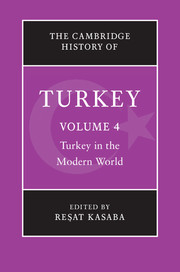Book contents
- Frontmatter
- 1 Introduction
- PART I OTTOMAN BACKGROUND AND TRANSITION
- PART II REPUBLIC OF TURKEY
- 7 Migration and Turkey: the dynamics of state, society and politics
- 8 The migration story of Turks in Germany: from the beginning to the end
- 9 Politics and political parties in Republican Turkey
- 10 Economic change in twentieth-century Turkey: is the glass more than half full?
- 11 Ideology, context and interest: the Turkish military
- 12 Kurds and the Turkish State
- 13 Islam and politics in contemporary Turkey
- 14 Sufism and Islamic groups in contemporary Turkey
- 15 Contestation and collaboration: women’s struggles for empowerment in Turkey
- 16 Art and architecture in modern Turkey: the Republican period
- 17 The novel in Turkish: narrative tradition to Nobel prize
- 18 A brief history of modern Istanbul
- Select bibliography
- Index
- References
7 - Migration and Turkey: the dynamics of state, society and politics
from PART II - REPUBLIC OF TURKEY
Published online by Cambridge University Press: 28 November 2009
- Frontmatter
- 1 Introduction
- PART I OTTOMAN BACKGROUND AND TRANSITION
- PART II REPUBLIC OF TURKEY
- 7 Migration and Turkey: the dynamics of state, society and politics
- 8 The migration story of Turks in Germany: from the beginning to the end
- 9 Politics and political parties in Republican Turkey
- 10 Economic change in twentieth-century Turkey: is the glass more than half full?
- 11 Ideology, context and interest: the Turkish military
- 12 Kurds and the Turkish State
- 13 Islam and politics in contemporary Turkey
- 14 Sufism and Islamic groups in contemporary Turkey
- 15 Contestation and collaboration: women’s struggles for empowerment in Turkey
- 16 Art and architecture in modern Turkey: the Republican period
- 17 The novel in Turkish: narrative tradition to Nobel prize
- 18 A brief history of modern Istanbul
- Select bibliography
- Index
- References
Summary
Introduction: from the late Ottoman period to the Turkish Republic
The Turkish Republic and its predecessor state, the Ottoman Empire, have been deeply shaped by migration in its many variations. The end of the Ottoman Empire was particularly marked by the forced displacement of people. As nationalism set out to establish homogenous national identities, the multi-ethnic and multicultural order of the Ottoman Empire was undermined. The collapse of the empire and the rise of nationalism, especially in Eastern Europe and the Balkans, were characterised by the ‘un-mixing’ of peoples and the dislocation of large numbers of Christians, Jews and Muslims. These displaced people came from a great variety of ethnic groups, including Armenians, Bosnians, Bulgarians, Circassians, Greeks, Kurds, Pomaks, Tatars and Turks. The population shifts of the Balkan and First World Wars were followed by a compulsory exchange of population between Greece and the new Turkish Republic, which saw the arrival of almost half a million Muslims.
Economic circumstances and state pressure both compelled Christian minorities living in an ever-contracting Ottoman Empire to emigrate. Some had already started to immigrate to the United States from the late nineteenth century onwards. Greeks and Armenians constituted almost half of the emigration from the Ottoman Empire to the United States, and this emigration intensified during 1900–1913 with the rise in Turkish nationalism. The massive forced migration of Christians, however, occurred mostly during the First World War and in its immediate aftermath. Armenians and Greeks were particularly affected.
- Type
- Chapter
- Information
- The Cambridge History of Turkey , pp. 173 - 198Publisher: Cambridge University PressPrint publication year: 2008
References
- 6
- Cited by



